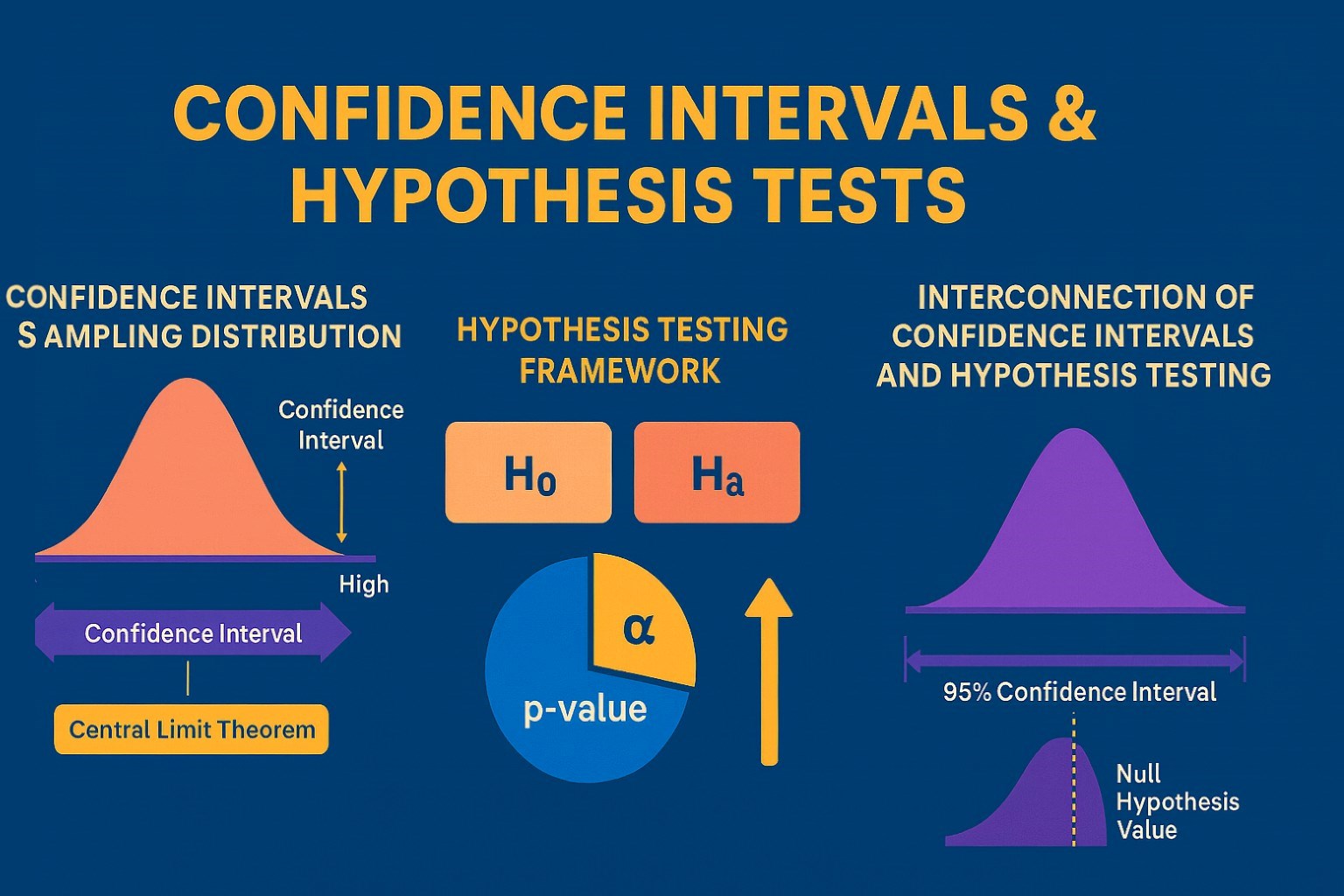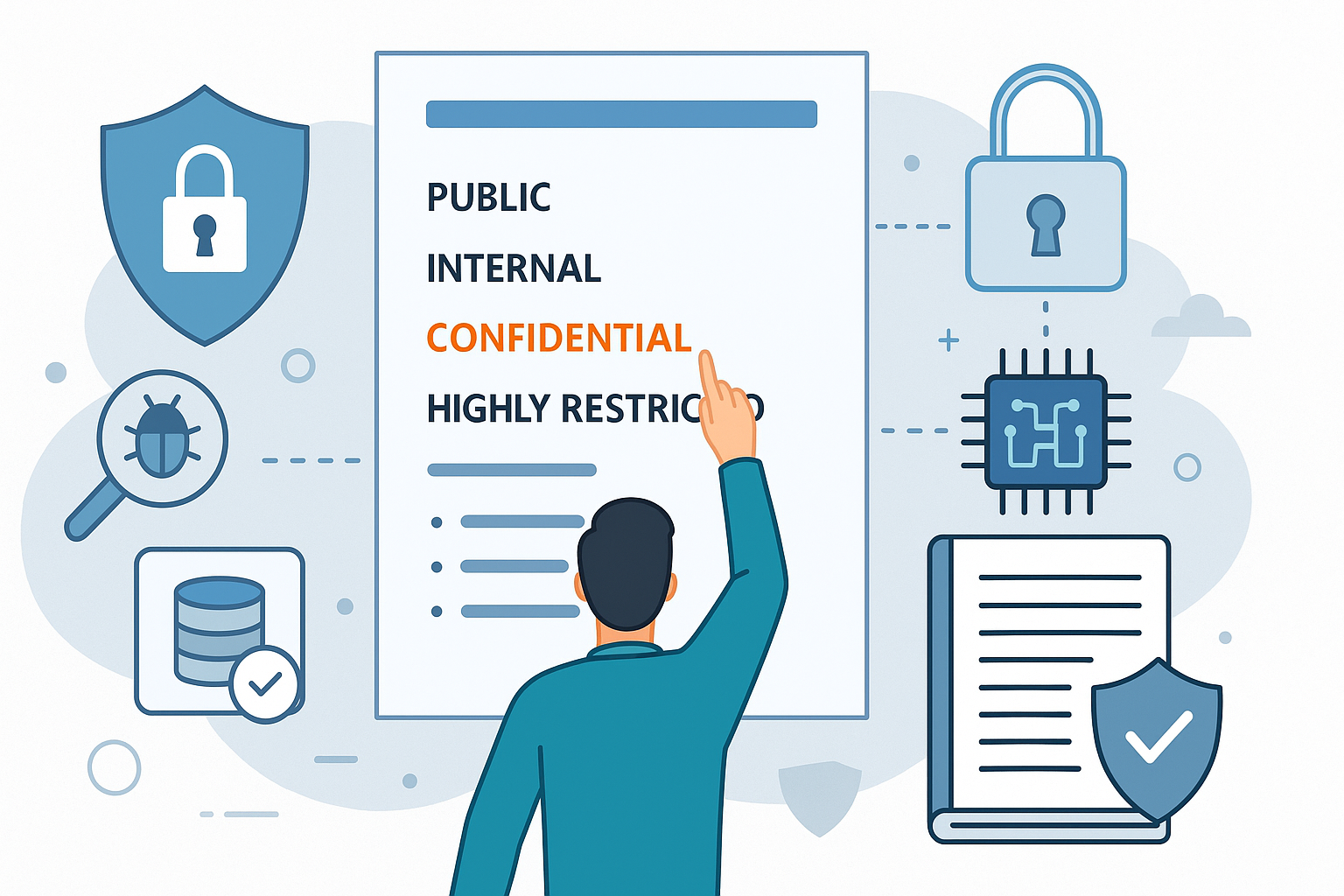Confidence Intervals & Hypothesis Tests: The Data Science Path to Generalization

In data science, statistical inference plays a vital role in making conclusions about entire populations based on sample data. Two fundamental tools used for this are confidence intervals and hypothesis tests, which together provide a robust framework to generalize findings beyond the data at hand.
Confidence Intervals and Sampling Distribution
A confidence interval provides a range of possible values within which a population parameter (like a mean) is likely to fall. It is derived based on the sampling distribution of the statistic and incorporates the margin of error to quantify uncertainty. The well-known Central Limit Theorem (CLT) supports this by stating that, with a large enough sample size, the sampling distribution approximates a normal distribution regardless of the original data's distribution.
Hypothesis Testing Framework
Hypothesis tests begin with two competing assumptions: the null hypothesis (H0), representing the status quo or no effect, and the alternative hypothesis (Ha), representing the effect or difference we want to detect. Using sample data and test statistics, hypothesis tests yield a p-value which, when compared to a pre-decided significance level (α), determines if there is enough evidence to reject the null hypothesis.
Interconnection of Confidence Intervals and Hypothesis Testing
Interestingly, both confidence intervals and hypothesis tests are rooted in the same statistical principles. A confidence interval at 95% confidence corresponds to a significance level (α) of 0.05 in hypothesis testing. If the confidence interval does not include the null hypothesis value, this suggests statistical significance and leads to rejecting the null hypothesis. Conversely, if the null value is within the interval, there is insufficient evidence to reject the null.
Importance in Data Science
By embracing these tools, data scientists enhance decision-making capabilities through quantitative evidence rather than intuition. Confidence intervals provide estimates with precision, whereas hypothesis tests validate the strength of results. This combined approach is essential for reliable predictions, experimental validations, and deriving insights that generalize well to real-world scenarios.
In summary, understanding and applying confidence intervals, hypothesis tests, sampling distributions, and concepts like null and alternative hypotheses, p-values, significance levels, and the Central Limit Theorem equips data scientists with a powerful statistical toolkit to embark on the path of generalization and robust inference.
Find a course provider to learn Data Science
Java training | J2EE training | J2EE Jboss training | Apache JMeter trainingTake the next step towards your professional goals in Data Science
Don't hesitate to talk with our course advisor right now
Receive a call
Contact NowMake a call
+1-732-338-7323Take our FREE Skill Assessment Test to discover your strengths and earn a certificate upon completion.
Enroll for the next batch
Data Science-Python-ML-AI-Deep Learning (Hands-on Training)
- Dec 15 2025
- Online
Data Science-Python-ML-AI-Deep Learning (Hands-on Training)
- Dec 16 2025
- Online
Data Science-Python-ML-AI-Deep Learning (Hands-on Training)
- Dec 17 2025
- Online
Data Science-Python-ML-AI-Deep Learning (Hands-on Training)
- Dec 18 2025
- Online
Data Science-Python-ML-AI-Deep Learning (Hands-on Training)
- Dec 19 2025
- Online
Related blogs on Data Science to learn more

Why Pursue Data Science Training?
Empower your career in a data-driven world. Learn why data science training is crucial for high-demand jobs, informed decisions, and staying ahead with essential skills.

Overview of data analytics VS data scientist
"Discover the key differences between data analytics and data science, explore top courses, job roles, salary expectations, and essential tools to build a successful career in these fields."

Career Launchpad: Data Science vs. Data Analytics- Know which course is right for you
Discover the key differences between Data Science and Data Analytics to choose the right course for your career. Explore roles, curriculum, salaries, and future prospects in this comprehensive guide.

What are Algorithms?
Discover the fundamentals of algorithms and data structures, their characteristics, types, and their crucial role in problem-solving and programming efficiency.

TEN ENTRY LEVEL JOBS IN IT FOR FRESHERS
Explore ten entry-level IT jobs for freshers, including roles like Help Desk Technician and Cloud Engineer, that require no prior experience but foundational IT knowledge. Discover exciting career paths in the technology sector that offer growth and

What is statistics?
Discover the basics of statistics, including its major types—descriptive and inferential—and their importance in data analysis and prediction.

Twelve High Paying Jobs in New York City
Uncover twelve high-paying jobs in New York City, including roles like data scientist and public relations manager. Learn about their responsibilities and salary ranges.

What is Linear Algebra?
Discover the importance of linear algebra in various fields like data science, economics, and medicine. Understand its applications and why it's an essential skill for students and professionals alike.

TEN ENTRY LEVEL JOBS IN IT FOR FRESHERS
Discover ten entry-level IT jobs perfect for freshers, offering exciting career opportunities and a pathway to success in the tech industry.

What is data management?
In this blog, we have covered what is data management, Data management process, and types of data management.
Latest blogs on technology to explore

From Student to AI Pro: What Does Prompt Engineering Entail and How Do You Start?
Explore the growing field of prompt engineering, a vital skill for AI enthusiasts. Learn how to craft optimized prompts for tools like ChatGPT and Gemini, and discover the career opportunities and skills needed to succeed in this fast-evolving indust

How Security Classification Guides Strengthen Data Protection in Modern Cybersecurity
A Security Classification Guide (SCG) defines data protection standards, ensuring sensitive information is handled securely across all levels. By outlining confidentiality, access controls, and declassification procedures, SCGs strengthen cybersecuri

Artificial Intelligence – A Growing Field of Study for Modern Learners
Artificial Intelligence is becoming a top study choice due to high job demand and future scope. This blog explains key subjects, career opportunities, and a simple AI study roadmap to help beginners start learning and build a strong career in the AI

Java in 2026: Why This ‘Old’ Language Is Still Your Golden Ticket to a Tech Career (And Where to Learn It!
Think Java is old news? Think again! 90% of Fortune 500 companies (yes, including Google, Amazon, and Netflix) run on Java (Oracle, 2025). From Android apps to banking systems, Java is the backbone of tech—and Sulekha IT Services is your fast track t

From Student to AI Pro: What Does Prompt Engineering Entail and How Do You Start?
Learn what prompt engineering is, why it matters, and how students and professionals can start mastering AI tools like ChatGPT, Gemini, and Copilot.

Cyber Security in 2025: The Golden Ticket to a Future-Proof Career
Cyber security jobs are growing 35% faster than any other tech field (U.S. Bureau of Labor Statistics, 2024)—and the average salary is $100,000+ per year! In a world where data breaches cost businesses $4.45 million on average (IBM, 2024), cyber secu

SAP SD in 2025: Your Ticket to a High-Flying IT Career
In the fast-paced world of IT and enterprise software, SAP SD (Sales and Distribution) is the secret sauce that keeps businesses running smoothly. Whether it’s managing customer orders, pricing, shipping, or billing, SAP SD is the backbone of sales o

SAP FICO in 2025: Salary, Jobs & How to Get Certified
AP FICO professionals earn $90,000–$130,000/year in the USA and Canada—and demand is skyrocketing! If you’re eyeing a future-proof IT career, SAP FICO (Financial Accounting & Controlling) is your golden ticket. But where do you start? Sulekha IT Serv

Train Like an AI Engineer: The Smartest Career Move You’ll Make This Year!
Why AI Engineering Is the Hottest Skillset Right Now From self-driving cars to chatbots that sound eerily human, Artificial Intelligence is no longer science fiction — it’s the backbone of modern tech. And guess what? Companies across the USA and Can

Confidence Intervals & Hypothesis Tests: The Data Science Path to Generalization
Learn how confidence intervals and hypothesis tests turn sample data into reliable population insights in data science. Understand CLT, p-values, and significance to generalize results, quantify uncertainty, and make evidence-based decisions.